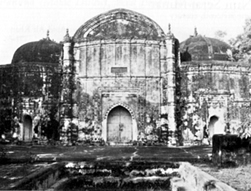Maldah Jami Mosque
Maldah Jami Mosque built in the southern part of the old Maldah town, occupies a mid-position between the Sultanate and the Mughal architecture of Bengal. An inscription records its construction in 1596 AD when this part of Bengal was under early Mughal occupation. The mosque is built just on the eastern side of the river, and is viewed distinctly from the nimsarai minar on the opposite side. Its plan is typically Mughal, already developed in Northern India, and consists of a rectangular prayer chamber surrounded by an enclosure wall, with a paved courtyard in front. The courtyard has in its middle a cistern (hawd) probably with a fountain (fowara), with three steps for descent.
Heavy towers on the corners strengthen the walls, the widest being that on the southwest, which accommodated the residence of the muadhdhan (Muajjin) in accordance with early Islamic custom. The mosque is entered through a gateway placed in the middle of the eastern enclosure-wall, and is almost similar to the entrance-portal to the prayer chamber.

The prayer chamber proper measures 22m north-south by 8m east-west. It consists of three parts - two side wings with curved elevation but covered with Mughal domes, and the central barrel vaulted nave with a peculiar pixtaq screening the front. The pishtaq, giving the appearance of a large portal, is not in the form of an iwan - a characteristic of Mughal architecture. But it frames the central doorways of a Sultanate design - two centred and engrailed with two flanking turrets which is typically Mughal. This hotchpotch must have been due to a compromise between the desire of the builder and the traditional design, which the workmen inherited. The cornice of the side wings, like the Sultanate mosques, are bow-curved, and the corner towers ring-moulded, but unlike Sultanate buildings which are of exposed bricks the entire building is covered with plaster, a Mughal feature in Bengal.
Like its contemporary, the Jami Mosque of Rajmahal (c 1595-1605), this mosque appear to be the last in a series of experimentation with gateway design which started with the adina mosque of Hazrat pandua and continued through the gunmant mosque of Gaur-Lakhnauti. With the stabilisation of the Mughal style, the design was abandoned, bringing forward the iwan-portal, which became the hallmark of Mughal architectural design in Bengal. [ABM Husain]
